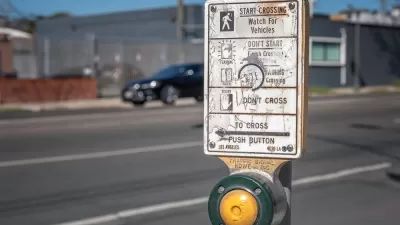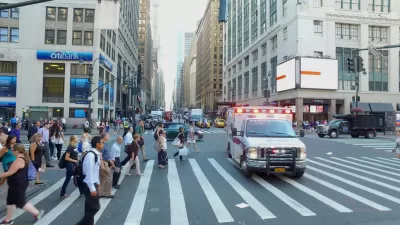With more driving comes a lot more deaths on the nation's roads. The question is why traffic deaths increase at a greater rate than vehicle miles traveled.
Joe Cortright analyses new data from the National Highway Traffic Safety Administration (NHTSA) showing "traffic related deaths are up 11.3 percent for the first nine months of 2015, as compared to the same period a year earlier."
Describing those findings as an "ominous trend," Cortright is willing to go further than the NHTSA in identifying a culprit for the increasing numbers of fatalities on the nation's roadways: the recent increase in driving.
What’s striking about the new NHTSA numbers is that road crash deaths are increasing much faster than total miles driven. As a result, the number of deaths per mile driven—which has been declining for decades—jumped up in the first three quarters of 2015, from 1.05 deaths per 100 million miles to 1.10 deaths per 100 million miles.
Cortright notes that the relationship between vehicle miles traveled (VMT) and driving deaths isn't new. In fact, " the same kind of disproportionate change occurred when gas prices increased in 2007-08. At that time, miles driven fell sharply—and traffic deaths fell even faster. In 2008, total vehicle miles traveled declined by 0.7% and in 2009, they declined a further 1.5 percent."
Cortright isn't alone in analyzing these trends, searching for the reasons why the relationship between traffic deaths and VMT is non-linear. Angie Schmitt reported on the same statistics for Streetsblog USA, sharing the theory of David Levinson about why deaths increase so much when VMT increases: "when gas prices fall, collisions rise faster than mileage because people who don’t ordinarily drive much, like teenagers, start driving more." Cortright also mentions research that shows high fuel prices inspire some motorists to slow down, thus reducing the number of fatal collisions.
FULL STORY: More driving means more dying

Alabama: Trump Terminates Settlements for Black Communities Harmed By Raw Sewage
Trump deemed the landmark civil rights agreement “illegal DEI and environmental justice policy.”

Planetizen Federal Action Tracker
A weekly monitor of how Trump’s orders and actions are impacting planners and planning in America.

The 120 Year Old Tiny Home Villages That Sheltered San Francisco’s Earthquake Refugees
More than a century ago, San Francisco mobilized to house thousands of residents displaced by the 1906 earthquake. Could their strategy offer a model for the present?

In Both Crashes and Crime, Public Transportation is Far Safer than Driving
Contrary to popular assumptions, public transportation has far lower crash and crime rates than automobile travel. For safer communities, improve and encourage transit travel.

Report: Zoning Reforms Should Complement Nashville’s Ambitious Transit Plan
Without reform, restrictive zoning codes will limit the impact of the city’s planned transit expansion and could exclude some of the residents who depend on transit the most.

Judge Orders Release of Frozen IRA, IIJA Funding
The decision is a victory for environmental groups who charged that freezing funds for critical infrastructure and disaster response programs caused “real and irreparable harm” to communities.
Urban Design for Planners 1: Software Tools
This six-course series explores essential urban design concepts using open source software and equips planners with the tools they need to participate fully in the urban design process.
Planning for Universal Design
Learn the tools for implementing Universal Design in planning regulations.
Clanton & Associates, Inc.
Jessamine County Fiscal Court
Institute for Housing and Urban Development Studies (IHS)
City of Grandview
Harvard GSD Executive Education
Toledo-Lucas County Plan Commissions
Salt Lake City
NYU Wagner Graduate School of Public Service





























